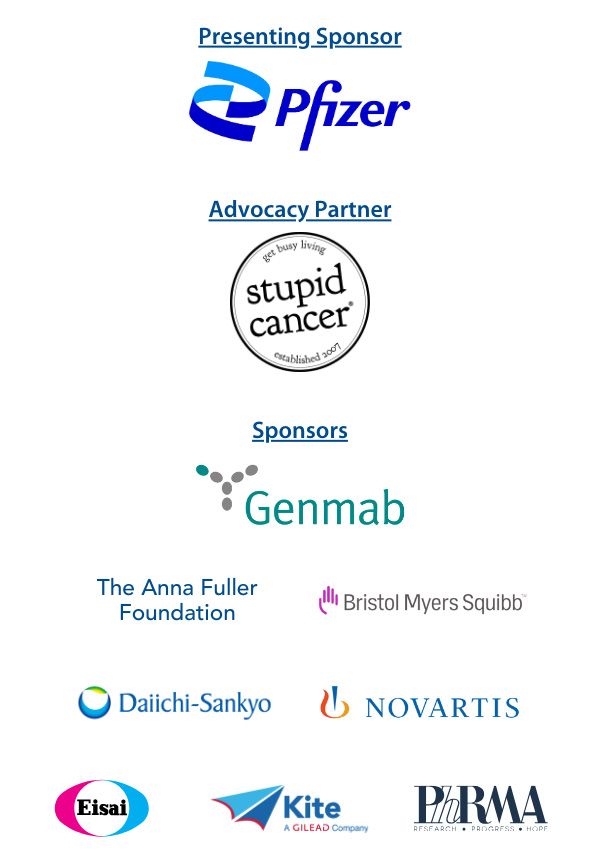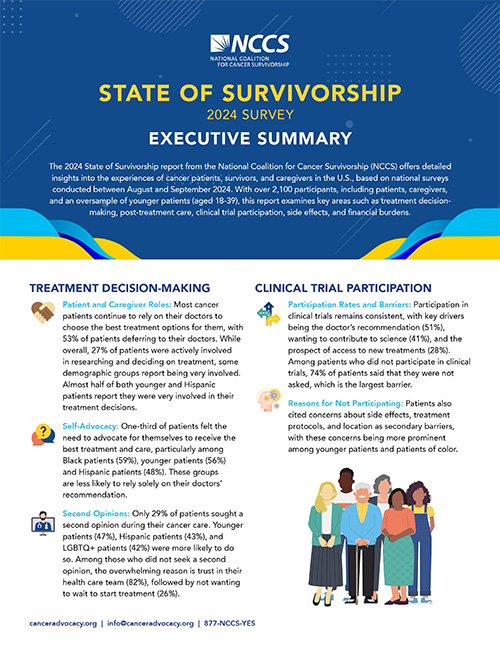Introduction
The 2024 State of Cancer Survivorship Survey report from the National Coalition for Cancer Survivorship (NCCS) offers detailed insights into the experiences of cancer patients, survivors, and caregivers in the U.S., based on national surveys conducted between August and September 2024.
With more than 2,100 participants, this report examines key areas such as treatment decision-making, post-treatment care, clinical trial participation, side effects, and financial burdens.
Our 2024 survey also introduced new questions, exploring reasons for participating — or choosing not to participate — in clinical trials, seeking second opinions, and experiences with survivorship care plans, among other topics.
Download The Report
Web Briefing
On October 30, NCCS hosted a web briefing to present the 2024 survey findings. Pam Loeb, Principal of Edge Research, and NCCS CEO Shelley Fuld Nasso discussed the results in detail and took questions from an audience of survivors, health care professionals, researchers, and more.
Briefing Topics
00:00 Introduction, Survey Objectives
05:03 Methodology & Who Responded
08:09 Patient/Caregiver Decision-Making
13:42 Second Opinions & Care Team Trust
18:02 Clinical Trials
21:21 Seeking Resources
23:50 Cancer Care Experiences
28:41 Side Effects
32:04 Financial Impacts
37:37 Work and School Impacts
40:37 Cancer Impacts on Caregivers
41:47 Post-Treatment Care Experience
47:23 Survivorship Care Plans
52:33 Q&A from Audience
The briefing recording can also be watched on YouTube.
The detailed findings slide deck of the 2024 survey data contains more data than is featured in the briefing. Download the full slide deck here »
Treatment Decision-Making
Patient and Caregiver Roles
Self-Advocacy
Second Opinions
Read more data about decision-making in the detailed findings slide deck. 2024 Detailed Findings (PDF) »
Clinical Trial Participation
Participation Rates and Barriers
Reasons for Not Participating
Read more data about clinical trials in the detailed findings slide deck. 2024 Detailed Findings (PDF) »
Post-Treatment Care and Survivorship Care Plans
Post-Treatment Care
Oncologists vs. PCP for Post-Treatment Care
Survivorship Care Plans
Read more data about survivorship care in the detailed findings slide deck. 2024 Detailed Findings (PDF) »
Financial Impacts of Cancer
Financial Burdens
Prescription Costs
Read more data about the costs of cancer in the detailed findings slide deck. 2024 Detailed Findings (PDF) »
Side Effects and Quality of Life
Most Common Side Effects
Symptom Management
Read more data about side effects and quality of life in the detailed findings slide deck. 2024 Detailed Findings (PDF) »
Employment and Work Impact
Employment Challenges
Work Productivity
Read more data about employment impact on patients and caregivers in the detailed findings slide deck. 2024 Detailed Findings (PDF) »
See More Charts and Data
The 2024 State of Survivorship Survey detailed findings presentation deck contains much more information, including data on additional topics and more detailed tables and charts.
Download the Detailed Findings (PDF) »
Download this Executive Summary (PDF) »
Request Survey Data
The National Coalition for Cancer Survivorship (NCCS) accepts requests from researchers and advocacy organizations wanting to use the State of Survivorship data set to support their research and practice for the purpose of improving quality of care for those touched by cancer.
Program Supporters





